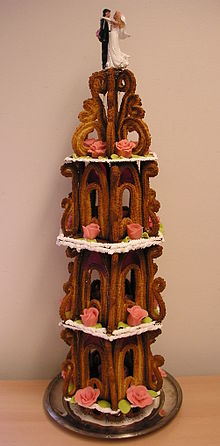
Confectionery is the art[1][2] of making confections, or sweet foods.[1][2] Confections are items that are rich in sugar and carbohydrates although exact definitions are difficult.[3] In general, however, confections are divided into two broad and somewhat overlapping categories: bakers' confections and sugar confections.[4]
Bakers' confectionery, also called flour confections, includes principally sweet pastries, cakes, and similar baked goods. Baker's confectionery excludes everyday breads, and thus is a subset of products produced by a baker.
Sugar confectionery includes candies (also called sweets, short for sweetmeats,[5] in many English-speaking countries), candied nuts, chocolates, chewing gum, bubble gum, pastillage, and other confections that are made primarily of sugar. In some cases, chocolate confections (confections made of chocolate) are treated as a separate category, as are sugar-free versions of sugar confections.[6] The words candy (Canada and US), sweets (UK, Ireland, and others), and lollies (Australia and New Zealand) are common words for some of the most popular varieties of sugar confectionery.
The occupation of confectioner encompasses the categories of cooking performed by both the French patissier (pastry chef) and the confiseur (sugar worker).[5] The confectionery industry also includes specialized training schools and extensive historical records.[7] Traditional confectionery goes back to ancient times and continued to be eaten through the Middle Ages and into the modern era.
- ^ a b "confectionery". Merriam-Webster.com Dictionary. Merriam-Webster. Retrieved 2 March 2021.
- ^ a b Cite error: The named reference
OED2023Confectionerywas invoked but never defined (see the help page). - ^ Davidson, Alan (2014). The Oxford Companion to Food. Oxford University Press. p. 213. ISBN 9780199677337.
- ^ International Food Information Service, ed. (2009). Dictionary of Food Science and Technology (2nd ed.). Chichester, U.K.: Wiley–Blackwell. p. 106. ISBN 9781405187404.
- ^ a b Goldstein, Darra (2015). The Oxford Companion to Sugar and Sweets. Oxford University Press. p. 171. ISBN 978-0-19-931339-6.
- ^ Edwards, W.P. (2000). The Science of Sugar Confectionery. Cambridge: Royal Society of Chemistry. p. 1. ISBN 9780854045938.
- ^ Day, Ivan. "The Art of Confectionery" (PDF). historicfood.com. Archived from the original (PDF) on 18 November 2017.